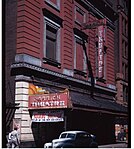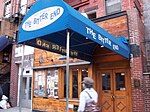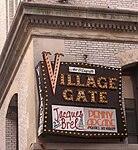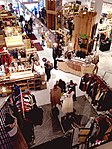Cafe Au Go Go
1964 establishments in New York City1969 disestablishments in New York (state)Cultural history of New York CityDefunct drinking establishments in ManhattanDrinking establishments in Greenwich Village ... and 2 more
Former music venues in New York CityNightclubs in Manhattan
The Cafe Au Go Go was a Greenwich Village night club located in the basement of the New Andy Warhol Garrick Theatre building in the late 1960s, and located at 152 Bleecker Street in Manhattan, New York City. The club featured many musical groups, folk singers and comedy acts between the opening in February 1964 until closing in December 1970. The club was originally owned by Howard Solomon who sold it in June 1969 to Moses Baruch. Howard Solomon became the manager of singer Fred Neil.
Excerpt from the Wikipedia article Cafe Au Go Go (License: CC BY-SA 3.0, Authors).Cafe Au Go Go
Bleecker Street, New York Manhattan
Geographical coordinates (GPS) Address Nearby Places Show on map
Geographical coordinates (GPS)
| Latitude | Longitude |
|---|---|
| N 40.728295 ° | E -73.999422 ° |
Address
Bleecker Street 149
10012 New York, Manhattan
New York, United States
Open on Google Maps









